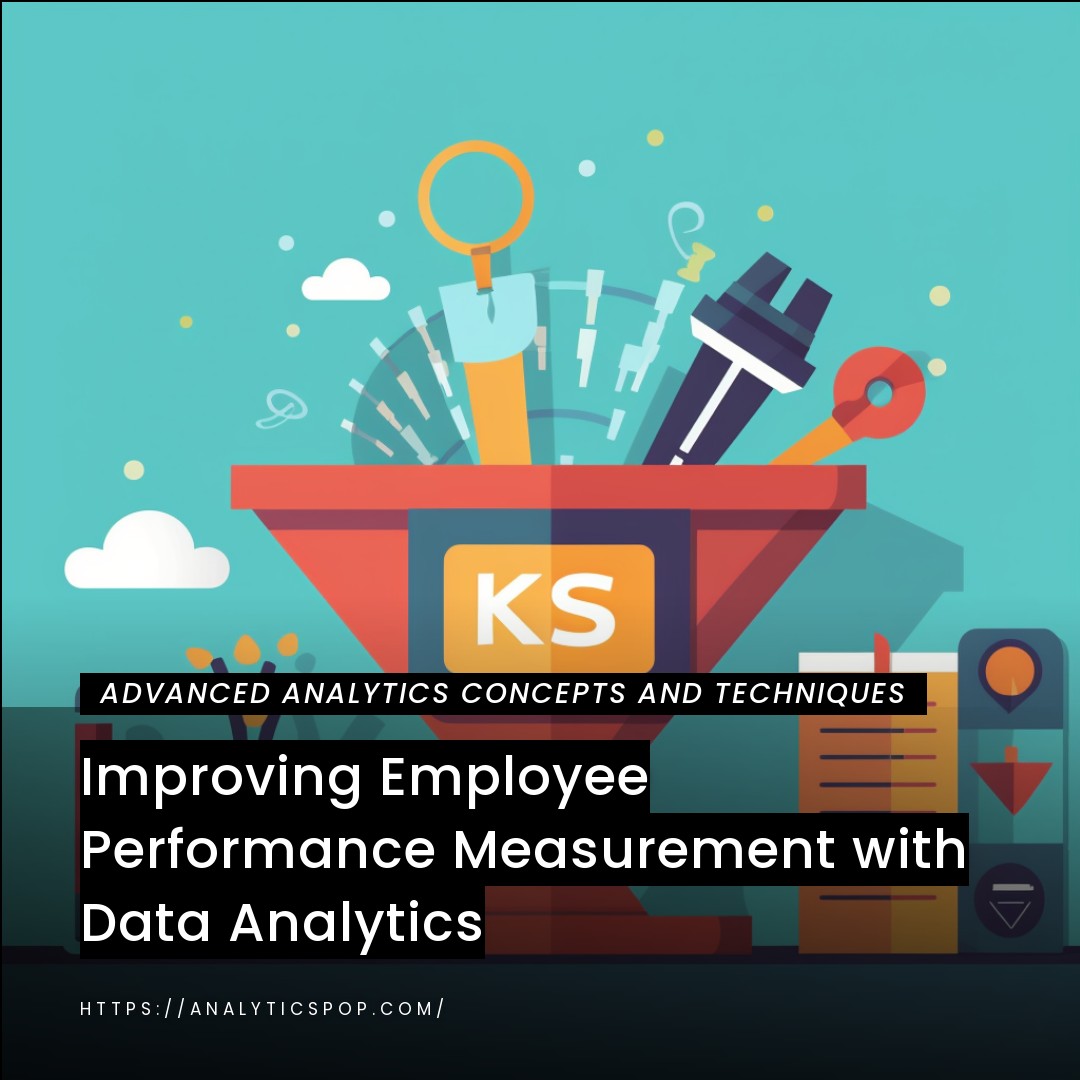Employee performance measurement is critical to human resource management, but evaluating performance accurately and objectively can be challenging. Data analytics can help organizations improve their employee performance measurement by providing valuable insights into employee behavior and performance.
One best practice for using data analytics to measure employee performance is to collect and analyze a wide range of data points. This may include quantitative data such as sales figures, customer satisfaction ratings, and attendance records, as well as qualitative data such as feedback from supervisors and peers.
By analyzing various data points, organizations can gain a complete picture of an employee’s performance and identify areas for improvement.
Another best practice is to use data analytics to set clear, measurable goals for employee performance. This helps employees understand what is expected of them and allows managers to evaluate progress and provide feedback. By setting clear goals and regularly measuring progress, organizations can create a culture of continuous improvement and help employees reach their full potential.
Data analytics can provide valuable insights into employee performance and help organizations improve performance measurement practices. Organizations can create a culture of continuous improvement and drive better business outcomes by collecting and analyzing a wide range of data points and setting clear, measurable goals.
Why Use Data Analytics for Employee Performance Measurement?
Employee performance measurement is a critical function of human resource management that helps organizations evaluate the effectiveness of their workforce. While traditional methods of performance measurement, such as employee surveys and performance reviews, can provide valuable insights, data analytics can take performance measurement to the next level.
Using data analytics for employee performance measurement allows organizations to collect and analyze large amounts of data quickly and accurately. This data may include sales figures, customer satisfaction ratings, productivity metrics, and other key performance indicators. By analyzing this data, organizations can identify patterns, trends, and correlations that may take time to become apparent using traditional methods.
Data analytics can also provide a more objective and unbiased view of employee performance. Subjective opinions may influence performance reviews and surveys, but data analytics relies on complex data and objective measures. This helps organizations evaluate employee performance more accurately and make more informed decisions about promotions, raises, and other workforce-related issues.
Using data analytics for employee performance measurement provides organizations with valuable insights and objective measures of performance. By leveraging data analytics, organizations can make more informed decisions about their workforce, identify areas for improvement, and drive better business outcomes.
An overview of the benefits of using data analytics for employee performance measurement
Data analytics has revolutionized the way organizations approach employee performance measurement. By leveraging data and advanced analytical tools, organizations can gain valuable insights into employee behavior and performance that were previously difficult or impossible to access.
Here are some of the key benefits of using data analytics for employee performance measurement:
- Improved accuracy: Data analytics provides an objective and unbiased view of employee performance that is not influenced by subjective opinions or biases. This can help organizations evaluate performance more accurately and make more informed decisions about promotions, raises, and other workforce-related issues.
- Greater efficiency: Data analytics allows organizations to collect and analyze large amounts of data quickly and accurately, reducing the time and resources required for performance measurement. This can help organizations make more informed decisions about their workforce in less time, driving greater efficiency and productivity.
- Identifying trends and patterns: Data analytics can help organizations identify trends and patterns in employee behavior and performance that may not be immediately apparent using traditional methods. This can help organizations identify improvement areas and proactively adjust their workforce strategy.
- Improved employee engagement: By using data analytics to set clear, measurable goals and provide regular feedback, organizations can create a culture of continuous improvement that promotes employee engagement and motivation.
- Enhanced decision-making: Data analytics provides valuable insights into employee performance that can inform decision-making across the organization, from HR to operations to finance. By leveraging data analytics, organizations can make more informed decisions about their workforce and drive better business outcomes.
The benefits of using data analytics for employee performance measurement are significant, providing organizations with a more accurate, efficient, and insightful approach to workforce management.

The limitations of traditional performance measurement methods
Traditional performance measurement methods, such as annual performance reviews and surveys, have been widely used by organizations for many years. However, these methods have several limitations that can limit their effectiveness in accurately measuring employee performance.
Here are some of the limitations of traditional performance measurement methods:
- Subjectivity: Traditional performance measurement methods rely on managers’ or peers’ subjective assessments of employee performance, which personal biases and opinions can influence.
- Limited data points: Traditional methods often rely on fixed data points, such as employee self-assessments or manager observations. This can provide an incomplete picture of employee performance.
- Time-consuming: Traditional performance measurement methods can be time-consuming and resource-intensive, requiring managers to devote significant time and effort to review and analyze data.
- Lack of agility: Traditional performance measurement methods are often conducted annually or semi-annually, limiting organizations’ ability to adapt quickly to changing business needs or employee performance issues.
- Inaccurate feedback: Traditional methods may need to provide timely and accurate feedback to employees, which can limit their ability to improve performance and reach their full potential.
Traditional performance measurement methods have several limitations that can impact their effectiveness in accurately measuring employee performance. As a result, many organizations are turning to data analytics and other advanced technologies to improve their performance measurement practices and drive better business outcomes.
How can data analytics provide deeper insights into employee performance and drive business outcomes?
Data analytics has emerged as a powerful tool for measuring employee performance and driving better business outcomes. By collecting and analyzing large amounts of data, organizations can gain valuable insights into employee behavior and performance that were previously difficult or impossible to access.
Here are some of the ways that data analytics can provide deeper insights into employee performance and drive business outcomes:
- Identifying performance trends: Data analytics can help organizations identify patterns and trends in employee performance over time. By analyzing data from multiple sources, organizations can gain a complete picture of employee performance and identify areas for improvement.
- Predictive modeling: Data analytics can help organizations develop predictive models that forecast future employee performance based on historical data. This can help organizations proactively address performance issues before they become significant problems.
- Personalized feedback: Data analytics can help organizations provide customized employee feedback based on their unique performance metrics. This can help employees understand their strengths and weaknesses and take proactive steps to improve their performance.
- Performance benchmarking: Data analytics can help organizations benchmark employee performance against industry standards or best practices. This can help organizations identify areas where they excel or areas where they need to improve relative to their peers.
- Driving strategic decision-making: Data analytics can provide valuable insights that inform strategic decision-making across the organization. By leveraging data analytics, organizations can make more informed decisions about their workforce strategy, identify areas for improvement, and drive better business outcomes.
Data analytics can provide deeper insights into employee performance and help organizations drive better business outcomes. By leveraging advanced analytical tools and techniques, organizations can gain a complete picture of their workforce and make more informed decisions about their talent strategy.
Key Metrics and Data Sources for Employee Performance Measurement
Employee performance measurement is a critical function of human resource management, and essential metrics and data sources play a crucial role in evaluating employee performance. Here are some of the vital metrics and data sources that organizations can use to measure employee performance:
- Sales figures: Sales figures can be an essential metric for measuring the performance of sales and customer-facing employees. Organizations can gain insights into employee performance and identify top performers by tracking sales revenue.
- Customer satisfaction ratings: Customer satisfaction ratings can provide valuable insights into employee performance in customer-facing roles. By tracking customer feedback, organizations can identify areas where employees excel and areas where they need improvement.
- Productivity metrics: Productivity metrics, such as the number of units produced or the number of tasks completed, can provide insights into employee performance in manufacturing or production roles.
- Attendance records: Attendance records can provide insights into employee reliability and commitment. By tracking attendance records, organizations can identify patterns of absenteeism or tardiness that may impact employee performance.
- Quality control metrics: Quality control metrics, such as defect rates or customer complaints, can provide insights into employee performance in quality control or production roles.
- Feedback from supervisors and peers: Feedback from supervisors and peers can provide valuable insights into employee performance and help identify areas for improvement.
The key metrics and data sources for employee performance measurement will depend on the organization’s industry, business model, and workforce strategy. By leveraging various data sources and metrics, organizations can gain a complete picture of employee performance and identify areas for improvement that can drive better business outcomes.

Defining relevant performance metrics, such as productivity, quality, and customer satisfaction
Defining relevant performance metrics is critical to accurately measuring employee performance and driving better business outcomes. Here are some of the key performance metrics that organizations can use to evaluate employee performance:
- Productivity: Productivity measures the output of an employee or a team relative to the resources used to produce that output. This can be measured in units produced, tasks completed, or other relevant metrics. High productivity indicates that employees work efficiently and effectively, which can drive better business outcomes.
- Quality: Quality measures the level of excellence in the work produced by an employee or a team. This can be measured regarding error rates, defect rates, or other relevant metrics. High quality indicates that employees have work that meets or exceeds expectations, enhancing customer satisfaction and driving better business outcomes.
- Customer satisfaction: Customer satisfaction measures customers’ satisfaction with an employee or a team’s work. High customer satisfaction indicates that employees meet or exceed customer expectations, which can drive customer loyalty and repeat business. This can be measured through surveys, feedback, or other relevant metrics.
- Attendance: Attendance measures the reliability and commitment of employees to their work. This can be measured regarding attendance rates, punctuality, or other relevant metrics. High attendance indicates that employees are reliable and committed, which can improve productivity and drive better business outcomes.
- Sales performance: Sales performance measures the level of success that employees or teams have in generating sales revenue. This can be measured in revenue generated, sales made, or other relevant metrics. High sales performance indicates that employees are effective at generating revenue, which can drive better business outcomes.
Defining relevant performance metrics is critical to accurately measuring employee performance and driving better business outcomes. By leveraging various metrics, organizations can gain a complete picture of employee performance and identify areas for improvement that can enhance productivity, quality, and customer satisfaction.
Identifying data sources for employee performance measurement, such as HR records and operational data
Identifying data sources for employee performance measurement is critical to accurately measuring employee performance and driving better business outcomes. Here are some of the essential sources of data that organizations can use to measure employee performance:
- HR records: HR records, such as employee data files, performance reviews, and disciplinary actions, can provide valuable insights into employee performance over time. Organizations can identify trends and patterns that inform workforce strategy and decision-making by tracking employee performance data in HR records.
- Operational data: Operational data, such as production output, sales figures, and customer feedback, can provide insights into employee performance in specific roles or departments. By tracking operational data, organizations can identify areas where employees excel and areas where they need improvement.
- Financial data: Financial data, such as revenue and profit margins, can provide insights into the impact of employee performance on the organization’s bottom line. Organizations can identify high-performing employees or teams by tracking financial data and rewarding them accordingly.
- Performance management software: Performance management software, such as goal-setting tools and performance dashboards, can provide a centralized location for tracking and analyzing employee performance data. By using performance management software, organizations can streamline performance measurement and gain valuable insights into employee performance.
- Customer feedback: Customer feedback, such as surveys and reviews, can provide insights into employee performance in customer-facing roles. By tracking customer feedback, organizations can identify areas where employees excel and areas where they need improvement.
Identifying relevant data sources for employee performance measurement is critical to accurately measuring employee performance and driving better business outcomes.
By leveraging various data sources, organizations can gain a complete picture of employee performance and identify areas for improvement that can enhance productivity, quality, and customer satisfaction.
Best practices for integrating and analyzing different types of employee performance data
Integrating and analyzing different types of employee performance data can be challenging, but it is critical to accurately measuring employee performance and driving better business outcomes. Here are some best practices for integrating and analyzing different types of employee performance data:
- Establish precise data collection and analysis processes: Establish transparent processes for collecting, cleaning, and analyzing employee performance data. This can help ensure data quality and consistency across different data sources.
- Use data visualization tools: Use data visualization tools, such as charts and graphs, to present employee performance data clearly and concisely. This can help stakeholders easily understand and interpret the data.
- Leverage advanced analytical tools: Leverage advanced analytical tools, such as predictive modeling and machine learning algorithms, to analyze large and complex sets of employee performance data. Using traditional analysis methods can help identify patterns that may take time to be apparent.
- Standatake time to metrics: Standardize performance metrics across different data sources to ensure consistency and comparability. This can help organizations identify trends and patterns in employee performance and make informed decisions based on the data.
- Involve stakeholders in the data analysis process: Involve stakeholders, such as managers and employees, in the data analysis process to ensure that the data is meaningful and actionable. This can help ensure that the analysis is relevant to the organization’s needs and can drive better business outcomes.
Integrating and analyzing different types of employee performance data requires careful planning, transparent processes, and advanced analytical tools. By following these best practices, organizations can gain valuable insights into employee performance and make informed decisions that drive better business outcomes.
FAQ's
Q: How can data analytics improve employee engagement and retention?
Employee engagement and retention are critical to business success, and data analytics can improve both. Here are some ways that data analytics can improve employee engagement and retention:
- Identifying key drivers of engagement: Data analytics can help organizations identify the key drivers of employee engagement, such as job satisfaction, work-life balance, and career development. Organizations can take targeted actions to improve employee engagement and reduce turnover by understanding these drivers.
- Personalizing employee engagement strategies: Data analytics can help organizations personalize employee engagement strategies based on individual employee preferences and needs. This can improve the effectiveness of engagement initiatives and help employees feel valued and supported.
- Providing real-time feedback: Data analytics can help organizations provide real-time feedback to employees, enabling them to make timely adjustments to their performance and behavior. This can increase employee engagement by providing employees with the information they need to succeed.
- Identifying flight risk: Data analytics can help organizations identify employees who may be at risk of leaving the organization, enabling them to take proactive steps to improve retention. By identifying flight risks early, organizations can take targeted actions to address the underlying issues and retain valuable talent.
- Enhancing the employee experience: Data analytics can help organizations understand the employee experience and identify areas for improvement. By enhancing the employee experience, organizations can improve engagement and retention and drive better business outcomes.
Data analytics can improve employee engagement and retention by providing valuable insights into employee behavior and performance. By leveraging advanced analytical tools and techniques, organizations can take targeted actions to improve concentration and retention and drive better business outcomes.

Q: What are some examples of successful implementation of data analytics for employee performance measurement?
Many organizations have successfully implemented data analytics to measure employee performance and significantly improve productivity, quality, and engagement. Here are some examples of successful implementation of data analytics for employee performance measurement:
- Google: Google uses data analytics to track employee performance and identify high-performing employees. By analyzing employee data, Google can identify patterns and trends that enable them to make informed decisions about promotions and other workforce-related issues.
- IBM: IBM uses data analytics to identify skills gaps and provide employees with targeted training and development opportunities. By leveraging data analytics, IBM can provide personalized learning experiences that improve employee performance and drive business outcomes.
- General Electric: General Electric uses data analytics to measure employee performance and identify areas for improvement. By analyzing employee data, General Electric can identify top performers and provide targeted coaching and development opportunities to employees who need it most.
- Airbnb: Airbnb uses data analytics to track employee engagement and retention. By analyzing employee data, Airbnb can identify flight risks and take proactive steps to improve retention and enhance the employee experience.
- Marriott International: Marriott International uses data analytics to measure employee performance and provide real-time employee feedback. By providing timely and actionable feedback, Marriott International can improve employee engagement and drive better business outcomes.
These examples demonstrate the power of data analytics for employee performance measurement and the significant improvements organizations can achieve by leveraging advanced analytical tools and techniques.
By taking a data-driven approach to performance measurement, organizations can gain valuable insights into employee behavior and performance and make informed decisions that drive better business outcomes.
Q: What are some best practices for ensuring data privacy and security in employee performance measurement?
Data privacy and security are critical when implementing employee performance measurement programs that leverage data analytics. Here are some best practices for securing data privacy and security:
- Implement data access controls: Implement strict access controls to ensure that only authorized individuals have access to employee performance data. This can include password protection, encryption, and multi-factor authentication.
- Anonymize data: Anonymize employee performance data by removing personally identifiable information to protect employee privacy. This can help prevent data breaches and unauthorized access to sensitive employee information.
- Secure data storage: Store employee performance data safely with restricted access. This can include cloud-based storage solutions or on-premise servers with physical access controls.
- Comply with data privacy regulations: Comply with data privacy regulations, such as the General Data Protection Regulation (GDPR) and the California Consumer Privacy Act (CCPA), to ensure that employee performance data is collected, stored, and used by applicable laws and regulations.
- Conduct regular security audits: Regular security audits identify potential vulnerabilities and ensure adequate security controls. This can include penetration testing and vulnerability assessments.
Overall, ensuring data privacy and security is critical when implementing employee performance measurement programs that leverage data analytics. By following these best practices, organizations can protect employee privacy, prevent data breaches, and maintain compliance with applicable laws and regulations.



